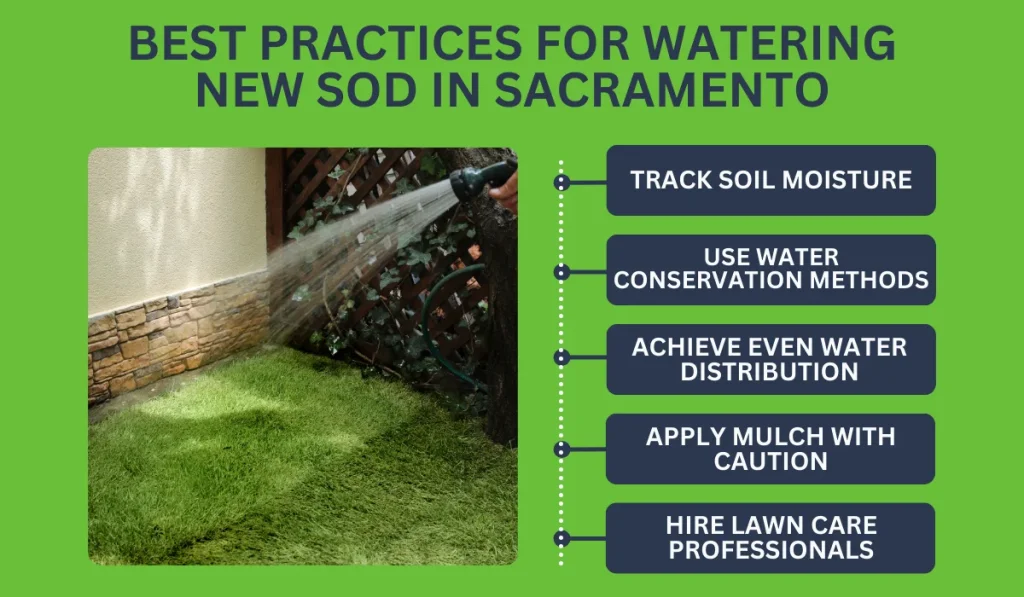Did you know that many Sacramento homeowners struggle with keeping their new sod properly watered during the hot summer months? Watering new sod can be tricky due to the region’s unique climate and soil conditions.
How can you ensure your lush, new lawn stays healthy and vibrant? Keep reading to discover essential tips and strategies for watering new sod effectively in Sacramento!
Key Takeaways
- New sod requires about 1 inch of water per day spread over 3-4 sessions during the first two weeks.
- Between weeks 3 and 4, reduce watering to once or twice daily, promoting root growth deeper into the soil.
- After the first month, transition to watering 2-3 times per week, encouraging a deep and resilient root system.
- Checking soil moisture, adapting to the weather, using water-saving techniques, and ensuring even distribution is crucial for sod care.
Watering Schedule for New Sod in Sacramento
Proper watering is crucial for new sod varieties like Fescues in Sacramento, California, to establish strong roots. The process changes over several weeks, adjusting the amount and frequency of watering.
Weeks 1-2: Intensive Watering
In the first week, new sod requires intensive watering to keep the soil moist. This initial phase is critical because it helps the sod roots penetrate deeply into the soil, ensuring a strong foundation. Gradually soaking the soil ensures that water penetrates deeply.
| Aspects | Details |
|---|---|
| Frequency | 3-4 times a day |
| Best Time | Early morning, mid-morning, or early afternoon |
| Amount of Water | About 1 inch of water per day |
Weeks 3-4: Reduce Water Frequency
During weeks 3-4, the watering frequency can start to decrease. This adjustment phase is vital for the sod to adapt and train the roots to seek water below the surface. Gradually use less water and increase the interval between sessions.
| Aspects | Details |
|---|---|
| Frequency | 3-4 times per week |
| Best Time | Early morning and early afternoon |
| Amount of Water | About 1-1 ½ inches of water |
After 4 Weeks: Standardizing Your Watering Plan
After 4 weeks, standardize how often you should water your lawn to maintain its health. This is the stage where the sod begins to look and act like an established lawn. Regular deep watering encourages a deep root system.
| Aspects | Details |
|---|---|
| Frequency | 2-3 times a week |
| Best Time | Early morning |
| Amount of Water | About 1-1 ½ inches of water per week |
Best Practices for Watering New Sod in Sacramento

Lawn watering in Sacramento requires careful attention to soil moisture, local climate, and water conservation practices.
Track Soil Moisture
Whether you have loamy, clay, or sandy soil, moisture is crucial for lawn needs. With hot, dry summers in Sacramento County, tracking soil wetness regularly is crucial. It ensures that the sod receives adequate water for root establishment.
Use Water Conservation Methods
Water conservation is essential, especially in drought-prone Sacramento. Incorporating water-saving techniques while deep, infrequent watering can help meet water restrictions.
Achieve Even Water Distribution
Even water distribution is crucial for turfgrass health. It ensures all areas receive moisture and prevents patchy, unhealthy lawns.
Using the right tools and techniques ensures uniform water coverage at any time of day. For instance, adjustable sprinkler systems provide even lawn hydration. Meanwhile, soaker hoses laid evenly across the sod area enhance distribution.
For areas requiring hand watering, systematically move the hose to maintain uniformity.
Apply Mulch with Caution
Mulching can be beneficial by retaining moisture, but too much can prevent water penetration. So, use organic mulching carefully for best results.
To ensure proper water absorption, apply a very thin layer of organic mulch, no more than one inch. Regularly track soil moisture and adjust the mulch to prevent water blockage, soggy soil, or runoff.
Hire Lawn Care Professionals
Professional help in the city of Sacramento can provide expertise in managing new sod. They can bring in-depth lawn care knowledge for warm- and cool-season grasses beyond fertilizing and mowing tips.
For maintaining a healthy sod lawn, they can provide expert guidance on soil and watering needs. They can also ensure optimal lawn health through routine maintenance.
Related: Overwatering or What? Why Your Grass Is Growing So Fast



